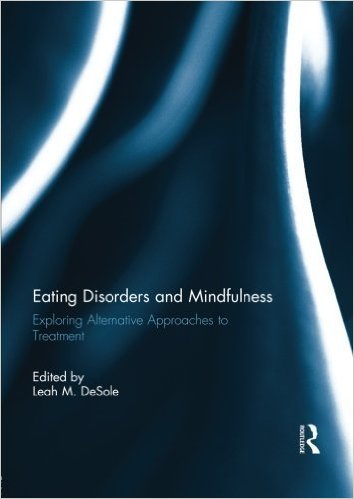
Reprinted from Eating Disorders Review
January/February Volume 24, Number 1
©2013 Gürze Books
(Leah H. DeSole, Editor. New York: Routledge, 2013. 164 pp; $145)
Mindfulness — as a perspective, an intervention, and a multifaceted movement, ancient as many meditative religious and non-religious traditions, ascendant as a ubiquitous cultural meme — is now to be found in all corners of health and mental health care, from wellness programs for caregivers to treatment programs for specific patient populations. Practicing mindfulness offers numerous subjective benefits: it’s centering, deeply relaxing, and in turn invigorating. In short, it leaves you feeling good, perhaps more thoughtful, and, just possibly, a bit healthier.
In Medicine, to large measure spurred by the pioneering, dedicated, and persistent contributions initiated decades ago by Jon-Kabat-Zinn at the University of Massachusetts, and originating in Buddhist meditative practices, “mindfulness” has been applied to a range of health conditions ranging from psoriasis and various aspects of immune function to chronic pain, with emphases on anxiety and stress reduction. In Mental Health circles, mindfulness practices have been incorporated into such diverse therapies as Dialetical Behavior Therapy (DBT), Acceptance and Commitment Therapy (ACT), and Modular Psychotherapy, with wide application to specific disorders.
As with many aspects of psychotherapeutic practices, it’s difficult to “unbundle” the effects of individual psychotherapy components used in complex treatments. These limitations apply to teasing-out potential specific contributions of “mindfulness” as well. But, before more refined types of evidence-based studies can be conducted, clinical observations and informal clinical trials are first steps in determining whether more substantial and rigorous clinical trials are warranted.
In this thin volume, Leah M. DeSole, a practicing psychologist in New York, has recast a special issue of the journal Eating Disorders: The Journal of Treatment and Prevention (Jan-Feb 2011), adding two new chapters to those papers, to bring together a nice collection of clinical, qualitative, and quantitative pieces focusing on the application of mindfulness practices to eating disorders. That this field is quite young is attested to by the fact that the meta-analytic study of Wanden-Berghe et al. uncovered only eight studies meriting inclusion, and among those the quality of experimental designs was highly variable and the sample sizes were generally too small to reach conclusions about findings.
Some of the premises for utility of mindfulness approaches stem from the nature and clinical features of individuals with eating disorders. As Merwin and colleagues illustrate, psychological inflexibility and rigidity in anorexia nervosa patients lend themselves to mindfulness approaches. Kristeller and Wolever also consider neurocognitive and self-regulatory models to describe how patients with binge eating disorder benefit from mindfulness-based eating awareness training.
The volume contains several reports and case series illustrating applications of mindfulness embedded in broader treatments. For example, mindfulness is shown combined with CBT or even yoga, or flying solo and used in a wide range of individual and group settings applied to anorexia nervosa, bulimia nervosa, binge eating disorder and subclinical conditions. Although there are no specific treatment manuals included in these writings, scripted vignettes including imagery exercises are described in sufficient detail so that readers not familiar with these practices can get a close view of what transpires.
One last issue. Although I’m not expert in business models driving the contemporary book publishing business, despite the inclusion of some photos, illustrations and graphics, I find it hard to get my head around the list price of $145 for this 164-page book. Although the material presented here is interesting and informative, readers who are mindful of costs might prefer acquiring copies of the journal issue from which this material is largely derived.
— JY
